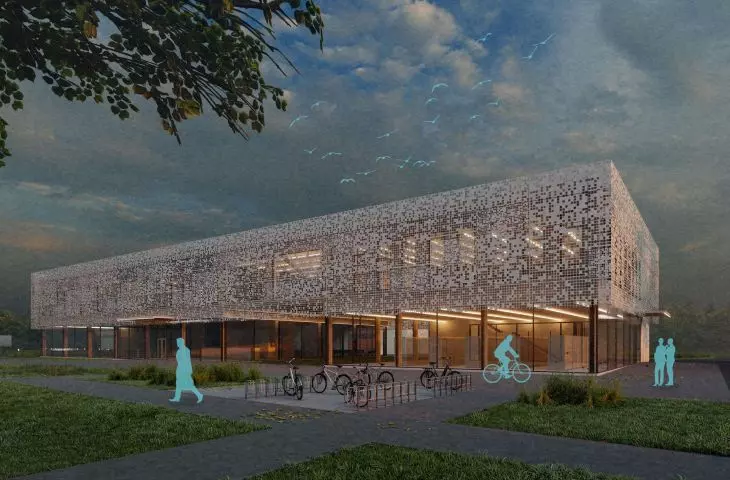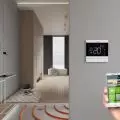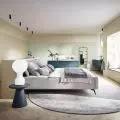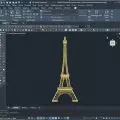Wroclaw University of Technology architecture students Wojciech Bandyk and Krystian Cięciwa have designed a supplement factory that could be built in Wroclaw. Their proposal is an environmentally friendly building divided into three blocks with a simple functional layout and a characteristic openwork facade. The authors also proposed spaces not only for employees, but also for the local community.
The proposed supplement factory could be built in Wrocław's Oporów industrial area. According to the authors, such a choice of location was dictated by good communication with Wrocław's S8 bypass, other parts of the city and a similar typology of neighboring buildings.
Design of the supplement factory, axonometry
© Wojciech Bandyk, Krystian Cięciwa
During the design process, we focused on creating a building with a simple functional layout using traditional systems and local building materials applied in the industrial zone. The exception is the representative and administrative zone of the building, where we used a post and beam and truss structural system made of GLT (glued laminated timber ). These treatments made it possible to effectively reduce the carbon footprint already at the conceptual level. The rotation of the complex in relation to the street allowed it to fit in with its surroundings and neighboring buildings, avoiding dominating the neighborhood, the students describe.
site development plan
© Wojciech Bandyk, Krystian Cięciwa
three blocks, multiplefunctions
The factory can be divided into three main blocks: a two-story representative-administrative block, a one-story production-laboratory block with a technical attic, and a warehouse block. On the first floor of block one, the students placed an entrance area with a catering area and kitchen facilities, pass checkrooms, multi-purpose rooms and a store with facilities and a boiler room supplying the establishment.
first floor plan of thecomplex
© Wojciech Bandyk, Krystian Cięciwa
On the first floor they designed an administrative area, a common area in the central part and a gym. This block is connected via a connector to the production-laboratory block. In its lower part, the authors envisaged social facilities for employees overlooking the semi-open atrium, while in the right part there is a laboratory. The first floor of the warehouse block includes warehouses for raw materials and finished products, as well as a sample archive, a shipping area, a drivers' room and an office in the central part of this space. The first floor includes locker rooms and staff facilities with access to an enclosed green atrium.
The openwork facade is illuminated with LED lights
© Wojciech Bandyk, Krystian Cięciwa
structure and elevations
The entire factory building was designed on a modular structural grid with a maximum span of 6.25 meters. The designs of the production and warehouse block were made using H-frame technology. The ventilated facade is made using the Kalzip sandwich panel system covered with Ruukki® Emotion exterior cladding. On the front façade of the warehouse block, students illuminated the openwork panels with LED lights, adding lightness to the heavy blocks. The roof was covered with structural trapezoidal sheeting insulated with hard glass wool panels.
© Wojciech Bandyk, Krystian Cięciwa
To reduce the local heat island, the designers proposed a white SOPRASTAR® FLAM roofing membrane that reflects the sun's rays. On the other hand, the representative and administrative block was made with GLT glulam construction. The facade is also covered with the Ruukki® Emotion system, while the first floor is decorated with a glass facade. The block is topped off with an extensive green roof.
floor plan
© Wojciech Bandyk, Krystian Cięciwa
pro-environmental and social values
Given the increasingly widespread desire for climate-neutrality of industrial buildings, we decided to introduce numerous solutions, realistically increasing the value of the project. We proposed: the use of local materials and efficient construction systems, extensive green roofs, reflective roofing, the planting of numerous trees, ventilated facades, photovoltaic panels on large-scale roofs, the reuse of rainwater in the facility and for irrigation of local greenery, or mechanical ventilation with heat recovery, the students list.
The authors also decided to reduce parking spaces, which they believe will encourage employees to use public transportation, bicycles and scooters - for which they provided racks.
Recreational and sports spaces have been created around the buildings
© Wojciech Bandyk, Krystian Cięciwa
Zones for employees and the local community should also be highlighted. After analyzing the functions, we proposed indoor gyms, a recreation and sports area and an outdoor playground surrounded by lush, diverse greenery. Introducing zones for the community in workplaces as well as in its surroundings is, in our opinion, one of the important aspects in timeless design, Wojciech and Krystian conclude.




































